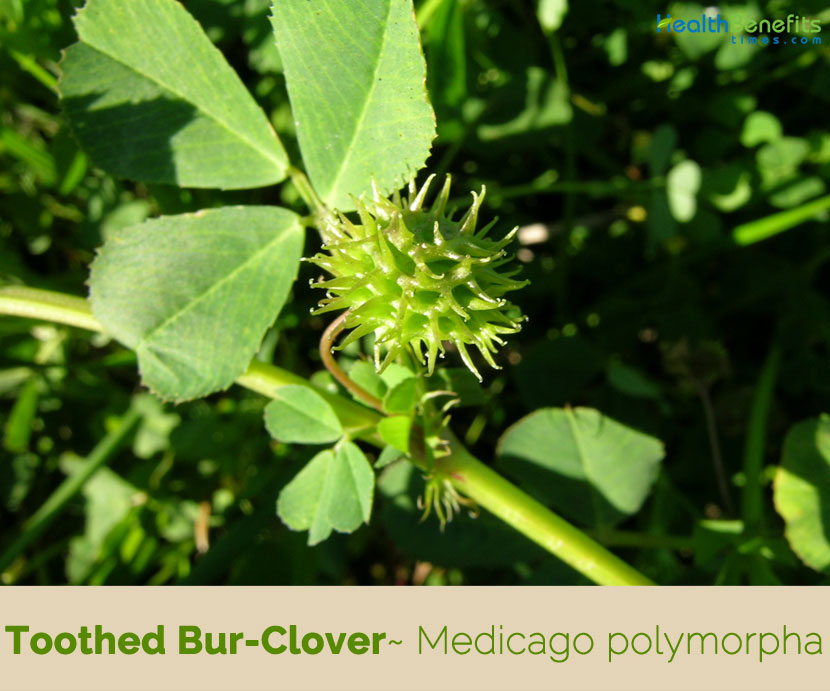Plant Description
Toothed Bur-Clover is an annual sprawling broadleaf legume plant that grows about 6-22 inches tall. The plant is found growing in open, dry to occasionally mesic, disturbed areas such as pastures, roadsides, vacant lots, desert regions, field borders, fallow fields, waste places, ditches and irrigation channels. The plant succeeds in practically all types of soils, but loams are most suitable. In the Southern US, the plants grow best in soils rich in lime, but will survive in poorer soils. It prefers moist, well drained soils, but in California it grows vigorously in adobe soils, which are often poorly drained. Root system has a tap root that is difficult to pull out when established. Stem is weak and reach a length of 60-75 cm. In thick stands, the stems may become erect, reaching to a height of 60 cm.
Leaves
New seedlings have seed leaves that are oblong. The first true leaf is rounded. Later leaves will be tripartite, with a characteristic clover-like shape, appearing alternately on the stems. Leaflets have slightly serrated edges. Leaflets are inverted-egg shaped, obovate to obcordate, 5–30 mm long, 3–22 mm wide, minutely dentate especially towards apex, both surfaces more or less glabrous, upper surface sometimes with darker flecks, apex truncate or emarginate with a terminal tooth. Stipules are 15 mm long, laciniate, glabrous or lower surface hairy.
Flowers
Being a member of the Leguminosae family, the flowers are clover-like, lipped and clustered. Bloom takes place from May to August in the plant’s native territory. Flowers (3–6 mm long) are small, bright yellow, and cluster into flower heads of 2 to 10 flowers at the stem tips. The tiny yellow flowers attract small butterflies and other pollinating insects.
Fruits
Fertile flowers are followed by seed pods, coiled in 2 to 5 spirals, forming a drum-shaped body are about 6–7 mm in diameter, the margins with straight or hooked spines as much as 3 mm long, or occasionally spineless. They start out green and relatively soft, but quickly turn brown and hard. Inside the pod are several kidney shaped seeds usually yellow or tan colored. The burred fruiting bodies can be quite difficult to remove from softer fabrics, such as fleeces and knitted socks.
Traditional uses and benefits of Toothed Bur-Clover
- It is used as a green manure, it fixes atmospheric nitrogen.
- Bur clover is used for medicinal purposes for skin plagues and dysentery.
- In Italy, bur clover leaf has been used for many centuries, such as medicinal purposes for treating rheumatic pains and wounds and is still used today.
Culinary uses
- Leaves and young shoots are consumed raw or cooked as a potherb.
- Only the young leaves are eaten raw.
- Flowers can be consumed raw or cooked.
- Seed are consumed after cooking.
- Seed can be parched, ground into a powder and mixed with water to make a mush.
- In tribal areas of Pakistan where many families have been displaced due to war, bur clover’s leaves and stems are used as pot vegetables in its fresh and dry form.
Other Facts
- Bur clover is mainly used as good quality forage.
- All classes of livestock, except horses and mules, eat it readily.
- Its use for sheep may raise problems because the prickly burs stick in the wool and can reduce its quality.
- Well-developed plants may contain more than 1000 pods.
- Bur clover flowers from 100-126 days after planting depending on location, time of seeding, and cultivars used.
- In the Bolivian Andes, bur clover has been used since the 16th century, for medicinal purposes, environmental uses, and animal feed.
- It is a useful plant for renovating worn out soils, and can be used in mild-winter areas as an autumn sown crop to prevent the erosion of cultivated soils.
References:
https://www.itis.gov/servlet/SingleRpt/SingleRpt?search_topic=TSN&search_value=503725#null
https://davesgarden.com/guides/pf/go/89863/
http://www.hear.org/pier/species/medicago_polymorpha.htm
https://npgsweb.ars-grin.gov/gringlobal/taxonomydetail.aspx?id=23645
https://pfaf.org/user/Plant.aspx?LatinName=Medicago+polymorpha
http://www.floracatalana.net/medicago-polymorpha-l-
https://plants.usda.gov/core/profile?symbol=MEPO3
http://www.theplantlist.org/tpl1.1/record/ild-8528
https://gd.eppo.int/taxon/MEDPO
https://en.wikipedia.org/wiki/Medicago_polymorpha
http://www.eu-nomen.eu/portal/taxon.php?GUID=B28F68E6-C3BE-476F-966C-E9EA779A017B
https://indiabiodiversity.org/species/show/264656
http://www.flowersofindia.net/catalog/slides/Bur%20Clover.html
https://www.feedipedia.org/node/276
https://plants.usda.gov/plantguide/pdf/pg_mepo3.pdf
http://ipm.ucanr.edu/PMG/WEEDS/california_burclover.html
Comments
comments
| Toothed Bur-Clover Quick Facts | |
|---|---|
| Name: | Toothed Bur-Clover |
| Scientific Name: | Medicago polymorpha |
| Origin | Europe, Central Asia, China, Japan, and North Africa |
| Colors | Green when young turning to brown as they mature |
| Shapes | Seed pods, coiled in 2 to 5 spirals, forming a drum-shaped body about 5 mm in diameter |
| Health benefits | Beneficial for skin plagues, dysentery, rheumatic pains and wounds |
